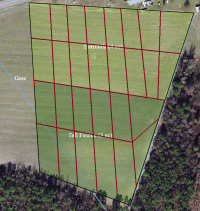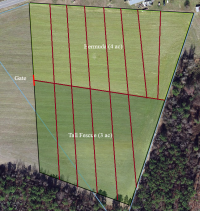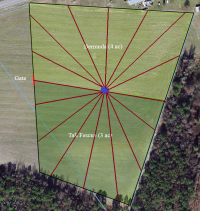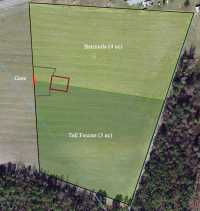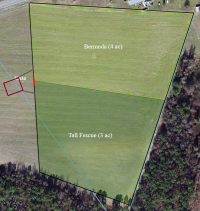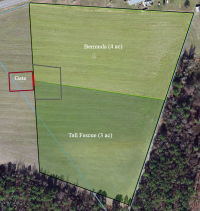ullbergm
Exploring the pasture
Good day, I'm brand new to this forum so I hope this is the appropriate sub forum to post this in since it has to do with sheep.
We are located in Eastern North Carolina and our goal is to get Katahdins this Spring with the goal of doing market lambs once we are established. We have been doing research for the couple of years, but there are so many different opinions out there.
In preparation for getting animals I spoke to the local Ag extension agent and it was recommended that I plant one summer grass section and one winter grass section in order to have forage growing through the year. I seeded 3 acres of novel endophyte tall fescue (Martin 2 Protek) in the Fall of 2020 and 3 acres of bermuda (Gaucho Bermudagrass) in the Spring of 2021.
The Bermuda is dormant right now but seems to have established nicely, we will see what it looks once it warms up. The Fescue has quite a bit of weeds in there and is not super thick, need to figure out if i need to fertilize it but I'm afraid that I'll fertilize the weeds at the same time..
The pasture has 6" wooden post H-braces in the corners and by the gate, the line posts are T-Posts and I have Red Brand 1348-4-12½ woven wire fence stretched around the perimeter.
I have electric service by the gate and the plan is to add electric fence to the perimeter and use that to hook the temporary fencing for the rotational grazing paddocks.
There are zero trees / shade as this used to be a farm field and I have not ran any water lines yet.
My question right now is how I should set up rotational grazing, plus another a million questions..
Should I do a wagon wheel plan with water in the center and paddocks fanning out from the center, or if i should try to do more rectangular sections.
Should i fence off a sacrificial area near the gate if i need to feed hay in order to let the pasture rest (drought, etc.)?
What about separating a ram from the ewes?
I know stocking rate depends a lot on how productive the pasture is, so our plan is to start with a smaller flock and expand if we see that the pasture can support more. What would be a good number to start with, not knowing how good the pasture is?
How big should the paddocks be?
Long-term plan is to build a barn by the gate.
Pasture dimensions:
West side: 580 ft
North side: 550 ft
East side: 700 ft
South side: 400 ft
Gate: 12 ft

We are located in Eastern North Carolina and our goal is to get Katahdins this Spring with the goal of doing market lambs once we are established. We have been doing research for the couple of years, but there are so many different opinions out there.
In preparation for getting animals I spoke to the local Ag extension agent and it was recommended that I plant one summer grass section and one winter grass section in order to have forage growing through the year. I seeded 3 acres of novel endophyte tall fescue (Martin 2 Protek) in the Fall of 2020 and 3 acres of bermuda (Gaucho Bermudagrass) in the Spring of 2021.
The Bermuda is dormant right now but seems to have established nicely, we will see what it looks once it warms up. The Fescue has quite a bit of weeds in there and is not super thick, need to figure out if i need to fertilize it but I'm afraid that I'll fertilize the weeds at the same time..
The pasture has 6" wooden post H-braces in the corners and by the gate, the line posts are T-Posts and I have Red Brand 1348-4-12½ woven wire fence stretched around the perimeter.
I have electric service by the gate and the plan is to add electric fence to the perimeter and use that to hook the temporary fencing for the rotational grazing paddocks.
There are zero trees / shade as this used to be a farm field and I have not ran any water lines yet.
My question right now is how I should set up rotational grazing, plus another a million questions..
Should I do a wagon wheel plan with water in the center and paddocks fanning out from the center, or if i should try to do more rectangular sections.
Should i fence off a sacrificial area near the gate if i need to feed hay in order to let the pasture rest (drought, etc.)?
What about separating a ram from the ewes?
I know stocking rate depends a lot on how productive the pasture is, so our plan is to start with a smaller flock and expand if we see that the pasture can support more. What would be a good number to start with, not knowing how good the pasture is?
How big should the paddocks be?
Long-term plan is to build a barn by the gate.
Pasture dimensions:
West side: 580 ft
North side: 550 ft
East side: 700 ft
South side: 400 ft
Gate: 12 ft

